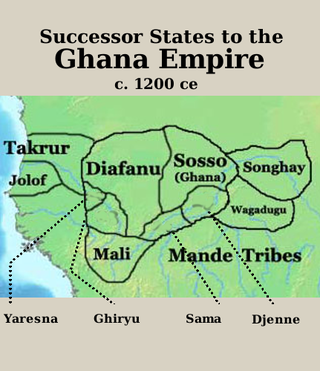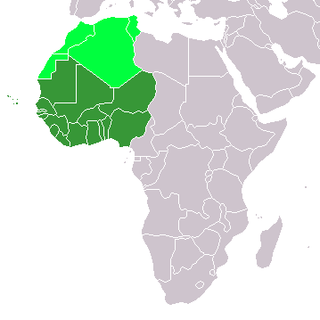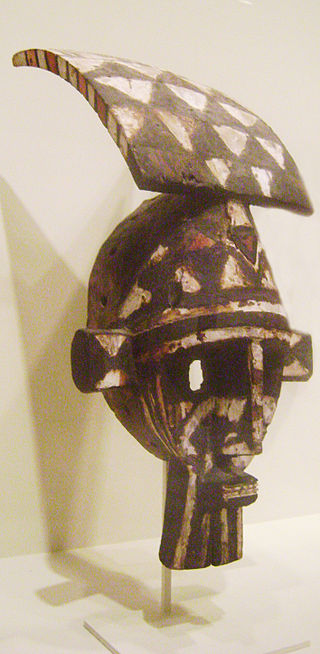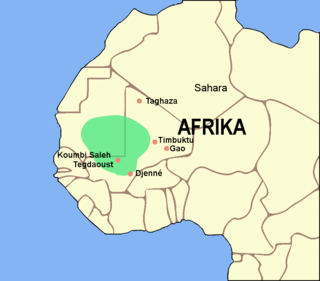The Soninke people are a West African ethnic group that is spread widely over the Sahel region. Their history, as recorded in oral traditions, medieval Arab writings, and modern archaeological and linguistic studies, extends into the first millenium BCE. The Soninke were the founders and rulers of the Ghana Empire, also known as Wagadou, as well as several smaller states such as Gajaaga, Guidimakha, and Kaarta.
The first ruler of this empire was said by Sonnike Griots to be the semi-divine Dingha Cisse. He was sometimes said to have come with his people from "the East", Aswan, Egypt or Mali, and created a coalition against the neighboring tribes and “nomadic raiders”. [1] In order to take power he had to kill a goblin, and then marry his daughters, who became the ancestors of the clans that were dominant in the region at the time. [2] Upon Dinga's death, his two sons Khine and Dyabe contested the kingship. [2] Dyabe, humiliated, made an accord with a black snake with seven heads named Bida. He promised to sacrifice a virgin to the snake once every year in return for victory over his brother. He fulfilled his promise to Bida until his death.
In 1969 Patrick Munson excavated at Dhar Tichitt (a site associated with the ancestors of the Soninke), which clearly reflected a complex culture that was present by 1600 BC and had architectural and material cultural elements similar to those found at Koumbi Saleh in the 1920s. [3] The earliest proto-polity ancestral to Ghana likely arose from a large collection of ancient proto-Mande agro-pastoralist chiefdoms that were spread over the western-most portion of the Niger River basin for over a millennium roughly spanning 1300 BCE – 300 BCE. [4] [5] [6] Munson theorized that, around 700 BCE Libyco-Berbers raiders destroyed this burgeoning state. [7] The opening of this route across the desert, however, eventually changed the economic calculus from raiding to trade, and the native Soninke reasserted themselves around 300 BCE. Saharan trade and the arrival of ironworking technology were crucial in the development of the state. [8] [9] [10] Work in Dhar Tichitt, Dhar Nema and Dhar Walata has shown that, as the desert advanced, the local groups moved southward into the still well-watered areas of what is now northern Mali. [11]
The Ghana Empire, also known by the Soninke name of Wagadou, thrived from approximately 300CE to 1100CE. Control over the trade routes transporting gold and other products, such as slaves, salt and copper, textiles, beads, and finished goods, made the empire rich. Eventually Islam became widely adopted. The rising power of the Almoravids and debilitating droughts caused the imperial core to weaken at the expense of former vassal states in the 12th century.
For the Soninke people, the decline of their empire was due to the legend of Wagadu and the rupture of the pact between the empire and the black snake. This happened after the nobles chose Siya Yatabare as the annual sacrifice. She was the most beautiful and “cleanest” virgin girl in that year, but she was also engaged to be married. Her fiancé, Maadi, was the son of Djamere Soukhounou whose unique quality was that he always did what he promised. When Maadi was told him what would happen, that his fiancée would be given to “Bida” - the black snake of Wagadu, he promised Siya that she would not die in the well of Wagadu.
Siya tried to convince him that it is her destiny, that he should let her to be the gift to the snake in order to save the Empire, but Maadi refused. Within days, he asked his friend, the blacksmith of his village named Bomou, to sharpen his saber. When the day came, Maadi set on his way in the direction of the well of Wagadu. Siya Yatabare was well dressed and her hairstyle was in plaited with gold. The praise-singer encouraged her, as did her family. When they left, she saw Maadi and they both fell in tears. Siya told him that if he killed the snake, Wagadu would not have any more rain and the empire would be destroyed forever. Maadi refused, saying their destinies are ratified. He left her and hid himself nearby to wait for the snake.
The snake of Wagadu had seven heads. When the snake took out his first head, Maadi cut it. He did the same to all the others. When the snake took out his last head, the one in silver, the night became clear like the day. The snake said, “I swear by the lord of seven head, during seven years and seven bad years, and during seven months and seven bad months, during seven days and seven bad days, Wagadu will not receive any rain and any piece of gold”. Maadi did not mind, and cut the last head. The snake died. Maadi gave to Siya his shoes, the sheath of his saber, his ring, his “danan koufoune” cap. He told her that, if tomorrow they ask you some clarifications, give them those things. Maadi went to his village and told all the details to his mother. She said “you are my only son and it is because of your fiancée that you killed the “Bida”, however, the nobles of Wagadu will try to punish you. I swear in the memory of your father that I will do everything to protect you from Wagadu.”
When the sun came up, the nobles asked the praise-singer to go check the well of Wagadu. When they saw Siya, and the heads of the snake in the well, they asked her what happened. As an answer, she gave them the shoes and all the things that Maadi gave her. The nobles of the 99 villages called everybody to come and try to wear the articles of clothing. When Maadi wore the shoes, the bonnet and the ring, everything fit. People knew that he killed the snake. They were going to take him when his mother intervened and said: “I thought there were men in Wagadu, but I do not see any. You are afraid of the prediction of the snake even before you die. But there is something sure, nobody will kill my son because of a snake. I do not see any men here. You will know that my loincloth is better than all your trousers accumulated here. During those seven bad years and seven bad months and seven bad days, the needs of wagadu would be in my charge as an exchange of my son’s life and his marriage with Siya Yatabare.”
With shame, the notables of Wagadu concluded the agreement. After Djamere Shoukhouna died, the nobles of Wagadu met and decided that she did what she promised and the agreement was at end and the destiny of the nation would be accomplished. Wagadu went from fertile to dry, and there was no more rain. The children of Dingha, the Soninke, were forced to leave that place which became inhospitable. Thus every family went to their destiny. [12]
After the fall of Wagadou, the Soninke dispersed throughout West Africa searching for more hospitable terrain. They merged with various ethnicities that they met, creating the Marka people, the Yarse, the Diakhanke and others. [13] Some even made it as far as the lands of the Akan people in modern-day Ghana, and to what is now northern Nigeria. [14] The Soninke successor kingdoms of Gajaaga and Kaarta survived, however. The Soninke diaspora has played an important role in the history of many polities in West Africa ever since.

The Mali Empire was an empire in West Africa from c. 1226 to 1670. The empire was founded by Sundiata Keita and became renowned for the wealth of its rulers, especially Mansa Musa. At its peak, Mali was the largest empire in West Africa, widely influencing the culture of the region through the spread of its language, laws, and customs.

Takrur, Tekrur or Tekrour was a state based in the Senegal River valley in West Africa which was at its height in the 10th and 11th centuries, roughly parallel to the Ghana Empire, but lasted in some form into the 18th century.

Sudano-Sahelian architecture refers to a range of similar indigenous architectural styles common to the African peoples of the Sahel and Sudanian grassland (geographical) regions of West Africa, south of the Sahara, but north of the fertile forest regions of the coast.

Oualata or Walata is a small oasis town in southeast Mauritania, located at the eastern end of the Aoukar basin. Oualata was important as a caravan city in the thirteenth and fourteenth centuries as the southern terminus of a trans-Saharan trade route and now it is a World Heritage Site.
Tichit, or Tichitt, is a partly abandoned village at the foot of the Tagant Plateau in central southern Mauritania that is known for its vernacular architecture. The main agriculture in Tichit is date farming, and the village is also home to a small museum.
The Mandé peoples are an ethnolinguistic grouping of native African ethnic groups who speak Mande languages. Various Mandé speaking ethnic groups are found particularly in the western regions of West Africa. The Mandé languages are divided into two primary groups: East Mandé and West Mandé.

The Soninke people are a West African Mande-speaking ethnic group found in Mali, southern Mauritania, eastern Senegal, The Gambia, and Guinea. They speak the Soninke language, also called the Serakhulle or Azer language, which is one of the Mande languages. Soninke people were the founders of the ancient empire of Ghana or Wagadou c. 200–1240 CE, Subgroups of Soninke include the Jakhanke, Maraka and Wangara. When the Ghana empire was destroyed, the resulting diaspora brought Soninkes to Mali, Mauritania, Senegal, Gambia, Burkina Faso, Côte d'Ivoire, Guinée-Conakry, modern-day Republic of Ghana, Kano in Nigeria, and Guinea-Bissau where some of this trading diaspora was called Wangara.

The Sosso Empire, also written as Soso or Susu, or alternatively Kaniaga, was kingdom of West Africa that originated as a vassal of the Ghana Empire before breaking away and conquering their former overlords. Inhabited by the Soninke ancestors of the modern-day Sosso people, it was centered in the region south of Wagadou and north of Beledougou. The empire peaked under the reign of Soumaoro Kante, who was defeated by the rising Mali Empire of Sundiata Keita.

The history of West Africa has been divided into its prehistory, the Iron Age in Africa, the period of major polities flourishing, the colonial period, and finally the post-independence era, in which the current nations were formed. West Africa is west of an imagined north–south axis lying close to 10° east longitude, bordered by the Atlantic Ocean and Sahara Desert. Colonial boundaries are reflected in the modern boundaries between contemporary West African states, cutting across ethnic and cultural lines, often dividing single ethnic groups between two or more states.
The Wangara are a subgroup of the Soninke who later became assimilated merchant classes that specialized in both Trans Saharan and Secret Trade of Gold Dust. Their diaspora operated all throughout West Africa Sahel-Sudan. Fostering regionally organized trade networks and Architecture projects. But based in the many Sahelian and Niger-Volta-Sene-Gambia river city-states. Particularly Dia, Timbuktu, Agadez, Kano, Gao, Koumbi Saleh, Guidimaka, Salaga, Kong, Bussa, Bissa, Kankan, Jallon, Djenné as well as Bambouk, Bure, Lobi, and Bono State goldfields and Borgu. They also were practicing Muslims with a clerical social class (Karamogo), Timbuktu Alumni political advisors, Sufi Mystic healers and individual leaders (Marabout). Living by a philosophy of mercantile pacifism called the Suwarian Tradition. Teaching peaceful coexistence with non-Muslims, reserving Jihad for self-defence only and even serving as Soothsayers or a "priesthood" of literate messengers for non-Muslim Chiefdoms/Kingdoms. This gave them a degree of control and immense wealth in lands where they were the minority. Creating contacts with almost all West African religious denominations. A group of Mande traders, loosely associated with the Kingdoms of the Sahel region and other West African Empires. Such as Ghana, Mali, Songhai, Bono State, Kong, Borgu, Dendi, Macina, Hausa Kingdoms & the Pashalik of Timbuktu. Wangara also describes any land south of Timbuktu and Agadez. The Bilad-Al-Sudan or Bilad-Al-Tibr, "Land of Black" or "Gold."

Pre-imperial Mali refers to the period of history before the establishment of the Mali Empire, an African empire located mostly in present-day Mali, in c. 1235.

The Marka people are a Mande people of northwest Mali. They speak Marka, a Manding language. Some of the Maraka (Dafin people are found in Ghana.

The Ghana Empire, also known as simply Ghana, Ghanata, or Wagadou, was a West African classical to post-classical era western-Sahelian empire based in the modern-day southeast of Mauritania and western Mali.
Takedda was a town and former kingdom located in present-day Niger. The archaeological site at Azelik wan Birni is believed to be the ruins of ancient Takedda.
Dia (Jà) is a small town and seat of the commune of Diaka in the Cercle of Ténenkou in the Mopti Region of southern-central Mali. It is situated at the western edge of the Inland Delta floodplain, and is watered by the Diaka, one of the Niger River's major distributaries and the only permanent watercourse in the region.
The Jakhanke -- also spelled Jahanka, Jahanke, Jahanque, Jahonque, Diakkanke, Diakhanga, Diakhango, Dyakanke, Diakhanké, Diakanké, or Diakhankesare -- are a Manding-speaking ethnic group in the Senegambia region, often classified as a subgroup of the larger Soninke. The Jakhanke have historically constituted a specialized caste of professional Muslim clerics (ulema) and educators. They are centered on one larger group in Guinea, with smaller populations in the eastern region of The Gambia, Senegal, and in Mali near the Guinean border. Although generally considered a branch of the Soninke, their language is closer to Western Manding languages such as Mandinka.
The Gao Empire preceded the Songhai Empire in the region of the Middle Niger. It owes its name to the town of Gao located at the eastern Niger bend, and was ruled by the Za dynasty.
Dhar Tichitt is a Neolithic archaeological site located in the southwestern region of the Sahara Desert in Mauritania. It is one of several settlement locations along the sandstone cliffs in the area. Tichitt culture includes Dhar Tichitt, Dhar Walata, Dhar Néma, and Dhar Tagant, and possibly sites from the Malian Lakes Region. Dhar Tichitt, which includes Dakhlet el Atrouss, may have served as the primary regional center for the multi-tiered hierarchical social structure of the Tichitt Tradition, and the Malian Lakes Region, which includes Tondidarou, may have served as a second regional center of the Tichitt Tradition. The cliffs of Dhar Tichitt were inhabited by farmers and pastoralists between 4000 BP and 2300 BP, or between 2000 BCE and 300 BCE.

The Tichitt Culture, or Tichitt Tradition, was created by proto-Mande peoples. In 4000 BCE, the start of sophisticated social structure developed among herders amid the Pastoral Period of the Sahara. Saharan pastoral culture was intricate. By 1800 BCE, Saharan pastoral culture expanded throughout the Saharan and Sahelian regions. The initial stages of sophisticated social structure among Saharan herders served as the segue for the development of sophisticated hierarchies found in African settlements, such as Dhar Tichitt. After migrating from the Central Sahara, proto-Mande peoples established their civilization in the Tichitt region of the Western Sahara. The Tichitt Tradition of eastern Mauritania dates from 2200 BCE to 200 BCE.
Diarra, also referred to as Kingui or Kaniaga was a Soninke state in what is now northwestern Mali, centered around the town of Diarra.